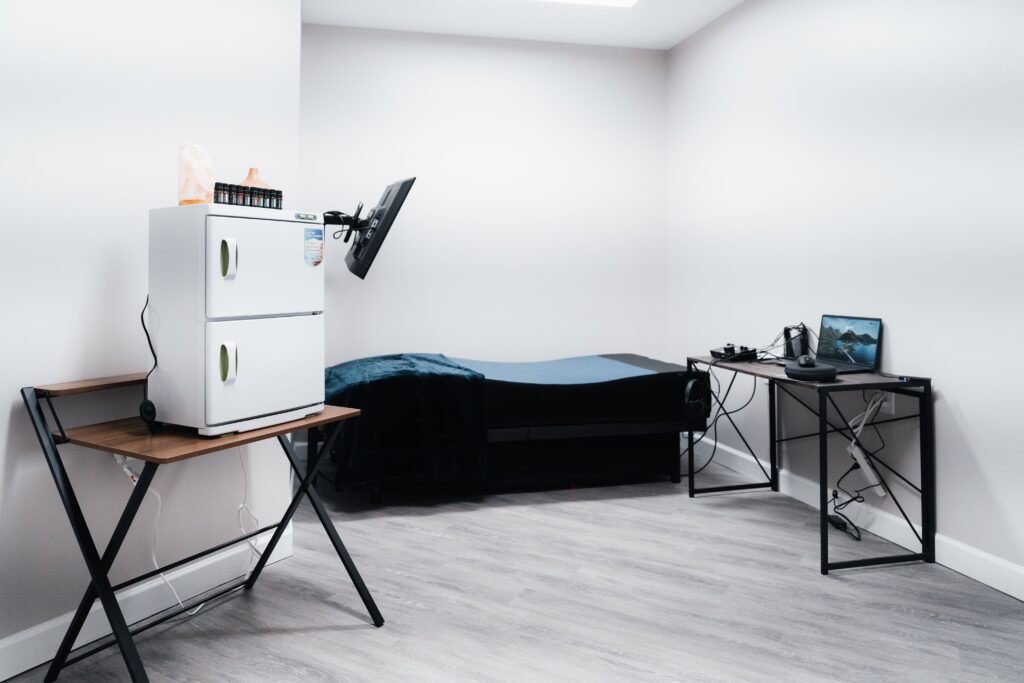Their names are somewhat similar, and they share a few features, but there are...
Read MoreTable of Contents

Medically Reviewed by
Dr. Thompson
Last updated: July 21, 2025
What is a Mood Disorder?
A mood disorder is a mental disorder characterized by persistent disturbances in a person’s emotional state that significantly affect their thoughts, behavior, and daily functioning. Unlike temporary emotional responses to life events, mood disorders involve prolonged periods of intense sadness, elevated mood, or fluctuations between emotional extremes that interfere with personal relationships, work performance, and overall quality of life.
These conditions involve changes in brain chemistry and function, making them legitimate medical conditions rather than character flaws or personal weaknesses. Mood disorders can affect anyone regardless of age, gender, race, or socioeconomic status, though certain factors may increase risk.
Types of Mood Disorders
Major Depressive Disorder (MDD)
Major Depressive Disorder (MDD) is characterized by persistent feelings of sadness, hopelessness, and loss of interest in activities once enjoyed. Episodes typically last at least two weeks and significantly impair daily functioning.
Bipolar Disorder
Bipolar Disorder involves alternating periods of depression and mania or hypomania. During manic episodes, individuals may experience elevated mood, increased energy, decreased need for sleep, and impulsive behavior. Bipolar I involves full manic episodes, while Bipolar II features hypomanic episodes with major depressive episodes.
Persistent Depressive Disorder (Dysthymia)
Persistent Depressive Disorder (Dysthymia) is a chronic form of depression lasting at least two years, with symptoms that may be less severe than major depression but are long-lasting and persistent.
Cyclothymic Disorder
Cyclothymic Disorder involves numerous periods of hypomanic and depressive symptoms that don’t meet the full criteria for bipolar disorder, lasting at least two years in adults.
Seasonal Affective Disorder (SAD)
Seasonal Affective Disorder (SAD) is a type of depression that occurs at specific times of the year, typically during fall and winter months when daylight hours are reduced.
Postpartum Depression
Postpartum Depression occurs after childbirth and involves severe mood changes, anxiety, and exhaustion that interfere with a mother’s ability to care for herself and her baby.
Step Inside Arbor Wellness
At Arbor Wellness, healing begins the moment you arrive. Our peaceful, modern facility is designed to support your recovery in a safe, comfortable, and welcoming environment. From thoughtfully furnished rooms to tranquil common spaces, every detail is built with your well-being in mind. Explore the video and photos below to see where your next chapter could begin.
Mood Disorder Statistics in the United States
According to the National Institute of Mental Health, approximately 9.7% of adults in the U.S. experience a mood disorder in any given year. Major depressive disorder affects about 8.5% of adults annually, making it one of the leading causes of disability worldwide.
Bipolar disorder affects approximately 2.8% of adults in the United States each year, with nearly 83% of cases classified as severe. Women are nearly twice as likely as men to experience major depressive disorder, while bipolar disorder affects men and women at similar rates.
The economic impact of mood disorders is substantial, with depression alone costing the U.S. economy over $200 billion annually in medical costs, lost productivity, and other expenses. Despite the availability of effective treatments, only about 60% of adults with mood disorders receive treatment in a given year.
Signs and Symptoms of a Mood Disorder
Recognizing the signs and symptoms of mood disorders is crucial for early intervention and treatment.
These symptoms must persist for specific durations and significantly impact daily functioning to warrant a mood disorder diagnosis.
Cognitive symptoms may involve difficulty concentrating, making decisions, or remembering information.
Commons Symptoms of Depression Include:
- Persistent sadness
- Feelings of hopelessness or worthlessness
- Loss of interest in activities
- Changes in appetite or weight
- Sleep disturbances, fatigue, difficulty concentrating, and thoughts of death or suicide.
Manic or hypomanic symptoms may include:
- Elevated or irritable mood
- Increased energy
- Decreased need for sleep
- Rapid speech
- Racing thoughts
- Distractibility
- Increased goal-directed activity
- Engaging in risky behaviors with potential negative consequences.
Physical symptoms can accompany mood disorders, including:
- Headaches
- Digestive issues
- Chronic pain
- Changes in appetite or sleep patterns.
Social and behavioral changes often occur, such as:
- Withdrawing from friends and family
- Declining work or academic performance
- Increased substance use, or engaging in reckless behaviors.
Learn More About Mood DIsorders
Discover more about recognizing, understanding, and managing mood disorders:
Mood Disorder vs. Personality Disorder
Mood disorders and personality disorders affect millions of people in the United States and...
Read MoreFacts About Mood Disorders
Today, we are going to review some facts about mood disorders to give you...
Read MoreStill have questions?
We’re here to help you find clarity and the right care.
Call us now or click below to verify your insurance and take the first step toward healing.
Risk Factors for Mood Disorders
Several factors can increase the likelihood of developing a mood disorder.
Biological Factors
Biological factors include genetics, with family history being a significant risk factor, as well as brain chemistry imbalances and hormonal changes during puberty, pregnancy, or menopause.
Environmental Factors
Environmental factors play a crucial role, including traumatic life events, chronic stress, major life changes, childhood trauma or abuse, and exposure to violence or neglect. Social factors such as isolation, relationship problems, financial difficulties, and lack of social support can also contribute to mood disorder development.
Medical Factors
Medical factors that may increase risk include chronic illnesses, certain medications, substance abuse, and other mental health conditions. Additionally, personality traits such as low self-esteem, perfectionism, or pessimistic thinking patterns may predispose individuals to mood disorders.
Lifestyle Factors
Lifestyle factors including poor sleep habits, lack of physical activity, poor nutrition, and excessive alcohol or drug use can also contribute to mood disorder risk. Understanding these risk factors helps in both prevention and early intervention strategies.
Causes of Mood Disorders
Mood disorders result from a complex interaction of biological, psychological, and environmental factors.
Biological Causes
Biological causes include genetic predisposition, with research showing that mood disorders often run in families. Neurotransmitter imbalances, particularly involving serotonin, dopamine, and norepinephrine, play crucial roles in mood regulation.
Brain Structure and Function
Brain structure and function differences have been observed in individuals with mood disorders, affecting areas responsible for emotion regulation, decision-making, and stress response. Hormonal fluctuations, particularly involving cortisol, thyroid hormones, and reproductive hormones, can significantly impact mood stability.
Psychological Factors
Psychological factors include negative thought patterns, low self-esteem, and maladaptive coping mechanisms. Traumatic experiences, particularly in childhood, can alter brain development and increase vulnerability to mood disorders later in life.
Environmental Triggers
Environmental triggers such as significant life stressors, relationship conflicts, job loss, or major life transitions can precipitate mood disorder episodes in vulnerable individuals. Seasonal changes, particularly reduced sunlight exposure, can trigger seasonal affective disorder.
The interaction between these various factors means that mood disorders are rarely caused by a single factor but rather result from multiple contributing elements working together.
How to Cope With A Mood Disorder
Developing effective coping strategies is essential for managing mood disorders and improving quality of life.
Establishing routine
Establishing routine provides structure and predictability, which can help stabilize mood and reduce anxiety. Regular sleep schedules, meal times, and daily activities create a foundation for emotional stability.
Physical activity
Physical activity has been shown to be highly effective in managing mood disorders, with regular exercise helping to regulate neurotransmitters, reduce stress hormones, and improve overall well-being. Even moderate activities like walking, swimming, or yoga can provide significant benefits.
Stress management techniques
Stress management techniques including deep breathing exercises, progressive muscle relaxation, meditation, and mindfulness practices can help individuals manage daily stressors and prevent mood episodes. Learning to identify and modify negative thought patterns through cognitive restructuring techniques is also valuable.
Social support
Social support is crucial for recovery and ongoing management. Maintaining connections with supportive friends and family members, joining support groups, and building a network of understanding individuals can provide emotional support and practical assistance.
Healthy lifestyle choices
Healthy lifestyle choices including proper nutrition, adequate sleep, limiting alcohol and avoiding drugs, and engaging in enjoyable activities can support mood stability. Creating a wellness plan that includes these elements provides a comprehensive approach to self-care.
Take Our Free Depression Quiz
Wondering if what you’re feeling could be depression?
Our quick, confidential depression screening can help you understand your symptoms and decide on your next steps.
Your mental health matters. Take the first step toward feeling better today.
How Is A Mood Disorder Diagnosed?
Diagnosing mood disorders requires a comprehensive evaluation by qualified mental health professionals. The diagnostic process typically begins with a detailed clinical interview exploring symptoms, their duration and severity, family history, medical history, and the impact on daily functioning.
Clinical Assessment
Clinical assessment involves using standardized diagnostic criteria, typically from the Diagnostic and Statistical Manual of Mental Disorders (DSM-5), to determine if symptoms meet specific criteria for mood disorder diagnoses. Mental health professionals evaluate symptom patterns, duration, and functional impairment to make accurate diagnoses.
Medical Evaluation
Medical evaluation is often necessary to rule out underlying medical conditions that might cause mood symptoms. This may include blood tests to check thyroid function, vitamin levels, and other medical markers, as well as reviewing current medications that might affect mood.
Psychological Testing
Psychological testing may be utilized to assess cognitive function, personality factors, and specific symptoms. Standardized questionnaires and rating scales help quantify symptom severity and track changes over time.
Collateral Information
Collateral information from family members, friends, or other healthcare providers can provide valuable insights into symptom patterns and functional impairment. This comprehensive approach ensures accurate diagnosis and appropriate treatment planning.
When To Seek Treatment
Recognizing when to seek professional help is crucial for effective mood disorder management.
thoughts of suicide, self-harm, or harming others
Immediate help should be sought if experiencing thoughts of suicide, self-harm, or harming others. Crisis hotlines, emergency departments, and mental health crisis services provide immediate support during acute episodes.
mood symptoms persist for more than two weeks
Professional evaluation is recommended when mood symptoms persist for more than two weeks, significantly interfere with daily activities, affect work or school performance, or strain relationships. If symptoms worsen despite self-help efforts or if there’s a history of mood disorders in the family, seeking professional help is advisable.
Quality of life indicators
Quality of life indicators suggesting need for treatment include persistent sadness or hopelessness, loss of interest in previously enjoyed activities, significant changes in sleep or appetite, difficulty concentrating, increased irritability, or social withdrawal.
Functional impairment
Functional impairment in areas such as work performance, academic achievement, relationship quality, or self-care abilities indicates the need for professional intervention. Early treatment typically leads to better outcomes and can prevent symptom progression.
Substance use concerns
Substance use concerns or engaging in risky behaviors as ways to cope with mood symptoms warrant immediate professional attention. These behaviors can worsen mood disorders and create additional complications.
Types of Mood Disorder Treatments
Effective treatment for mood disorders typically involves a combination of therapeutic approaches tailored to individual needs and preferences.
Medication Management
Medication management plays a crucial role in treating mood disorders, with various classes of medications available to help stabilize mood and reduce symptoms.
Antidepressants, including selective serotonin reuptake inhibitors (SSRIs), serotonin-norepinephrine reuptake inhibitors (SNRIs), and other classes, can help regulate neurotransmitter levels and alleviate depressive symptoms. Mood stabilizers such as lithium and anticonvulsants are often prescribed for bipolar disorder to prevent mood episodes and maintain stability.
Psychotherapy
Psychotherapy provides essential tools for understanding and managing mood disorders. Cognitive-behavioral therapy (CBT) helps individuals identify and modify negative thought patterns and behaviors that contribute to mood symptoms. Dialectical behavior therapy (DBT) teaches emotional regulation skills and distress tolerance techniques.
Interpersonal therapy (IPT) focuses on improving relationship patterns and communication skills that may contribute to mood difficulties. Psychodynamic therapy explores unconscious patterns and past experiences that influence current mood and behavior.
Holistic Therapy Approaches
Holistic therapy approaches complement traditional treatments by addressing the whole person, including physical, emotional, and spiritual aspects of well-being. These may include art therapy, music therapy, yoga, meditation, and nutritional counseling.
For individuals with severe mood disorders or those who haven’t responded to outpatient treatment, residential treatment programs provide intensive, comprehensive care in a supportive environment. These programs typically combine medication management, individual and group therapy, holistic approaches, and skill-building activities to promote healing and recovery.
Residential treatment allows for 24-hour monitoring and support, making it particularly beneficial for individuals with severe symptoms, suicide risk, or co-occurring conditions. The structured environment provides safety while individuals learn coping skills and work toward stabilization.
You Are Not Alone.
You Deserve To Get Help.
Arbor Wellness is an industry leader in mental health treatment. Our team of top medical experts specialize in dual diagnosis treatment and are committed to ensuring that each patient is treated as an individual.
Call us today, we’re available 24/7.
Insurance Can Help Cover the Cost of Treatment
We work with most major health insurance plans—including those with out-of-network benefits—to help make detox and recovery more affordable.
Click below to verify your coverage and explore your options today.





































